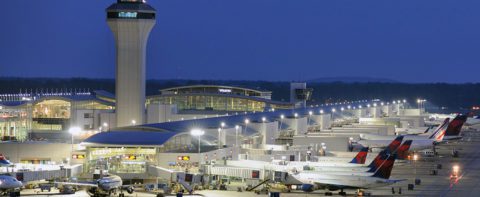The Detroit, Toledo, and Windsor region is crucial for moving goods throughout the Midwest and North America. Combined, the region has the capacity, skills, and world-class infrastructure to move products both efficiently and effectively through one of the country’s most complex supply chains. With major airports, railroads, and some of the busiest border crossings connecting North America and Canada, the region serves a premier gateway to the Midwest.

Economic Impact of Cross-border Trade
- In 2022, Michigan exported more than $61.1 billion worth of goods. The state’s top trading partner was Canada, exporting more than $26.3 billion worth of goods.
- Michigan was the #1 exporter of transportation equipment in 2022, exporting more than $27.4 billion in products accounting for 45% of all goods exported.
- Michigan was the #2 largest exporter of merchandise to Canada, with almost all merchandise handled in Detroit and Port Huron.
- In 2021, the Detroit MSA exported $35.43 billion, accounting for 63% of Michigan’s total merchandise exports. The Detroit metro ranked 9th largest exporter among U.S. metro areas

Explore an interactive dashboard of exports by industry for the Detroit region
For more information, please visit the Detroit Data Center.
Explore NowLogistics Advantages
The Detroit, Toledo, and Windsor region has a unique advantage in that it is an international trade corridor boasting trade cooperation on both sides of the Detroit River. The Detroit port sits 988 miles from Halifax and 618 miles from Montreal, making the Detroit region ideal for entering the United States and moving goods throughout the Midwest and North America.
New and expanding companies need a well-connected and efficient transportation system. The Detroit region serves as the busiest northern border crossing into Canada and sits along the St. Lawrence Seaway. The region is home to a world-class transportation, logistics, and distribution center, The Detroit region exported more than $35.4 billion in 2021, which accounted for 63% of Michigan’s merchandise exports.
Top 5 Export Sectors in the Detroit Region, 2021
| Sector | Value (in Billions) | Market Share (%) |
| Transportation Equipment | $19.6 | 56.0 |
| Computer and Electronic Products | $2.9 | 8.3 |
| Machinery Manufacturing | $2.5 | 7.1 |
| Electrical Equipment, Appliances | $2.3 | 6.6 |
| Fabricated Metal Products | $2.1 | 6.0 |
| Total | $29.4 |
Top Export Markets in the Detroit Region, 2021
| Country | Value (in billions) | Market Share (%) |
| Mexico | $13.6 | 38.9 |
| Canada | $12.9 | 36.9 |
| China | $1.4 | 18.6 |
| Brazil | $0.6 | 1.7 |
| Germany | $0.6 | 1.7 |
Intermodal Assets
The Detroit region’s transportation, distribution, and logistics industry is supported by seven international border crossings and ranks as the busiest northern border crossing in North America. Within the region, there are two bridges, two rail tunnels, two truck ferries, and the Detroit-Windsor Tunnel. In addition, the region is supported by nine airports and airfields, three marine ports, and eight railyards. In addition, the region’s 11 interstates reach from Canada to Mexico via Detroit. The Detroit, Toledo, and Windsor ports are among the largest along the St. Lawrence Seaway.
Water Ports
- The Detroit Port is the second largest customs port of entry in the U.S. by the value of goods.
- Annually, the Detroit Port oversees more than 17 million tons of cargo at 29 private and public terminals. High-grade steel products, coal, iron ore, and cement are some of the products shipped via the Port. The Detroit Port is ranked the third largest steel-handling port in the U.S.
- The Port of Windsor is made of more than 13 miles of shoreline and is the third largest Canadian-Great Lakes port.
- The Toledo Port is comprised of 15 marine terminals, which handle nearly all types of commodities transported via waterways.

Interstates
The trade region is supported by 11 interstates that reach from Canada to Mexico and connect the Detroit region to both the east and west coasts. Within Southeast Michigan, there are nearly 4,900 truck route miles of highways and roads.
The Detroit trade corridor is positioned to assist trucking companies with lowering their costs associated with truck delays in high congested markets such as Chicago.

Bridges
- Detroit and Port Huron are the second and fourth busiest border crossings in North America.
- More than 11,00 trucks cross the Detroit and Port Huron border crossings.
- The Gordie Howe International Bridge is projected to open in 2024, helping increase border trade.
Rail
Through service agreements, all major railroads serve the trade corridor and are able to ship throughout North America.
- The Detroit region is served by four of the seven national Class I railroads in the United States, unique to only 1/3 of the United States.
- There are more than 3,600 miles of track in Michigan.
- Three of the four railroads have intermodal terminals in the Detroit region.
Air
The economic region is home to 9 airports with more than $1.1 billion annually in cargo and nonstop service to more than 160 destinations.
- Within the 10-county Detroit region, there are 5 major airports and several airfields.
- Detroit Metro Airport (DTW) ranks #1 in customer satisfaction for mega airports with more than 1,100 daily flights and more than 35 million passengers served annually.
- DTW is an enormous Delta hub with 121 destinations served, 460 departures during peak-day, and more than 24 million customers in 2018.
Intermodal Facilities
- There are nine intermodal freight facilities spread throughout the Detroit region.
- More than 70% of the freight traffic in the region is handled by the trucking industry.

Learn more about transportation, distribution, and logistics in the region.




